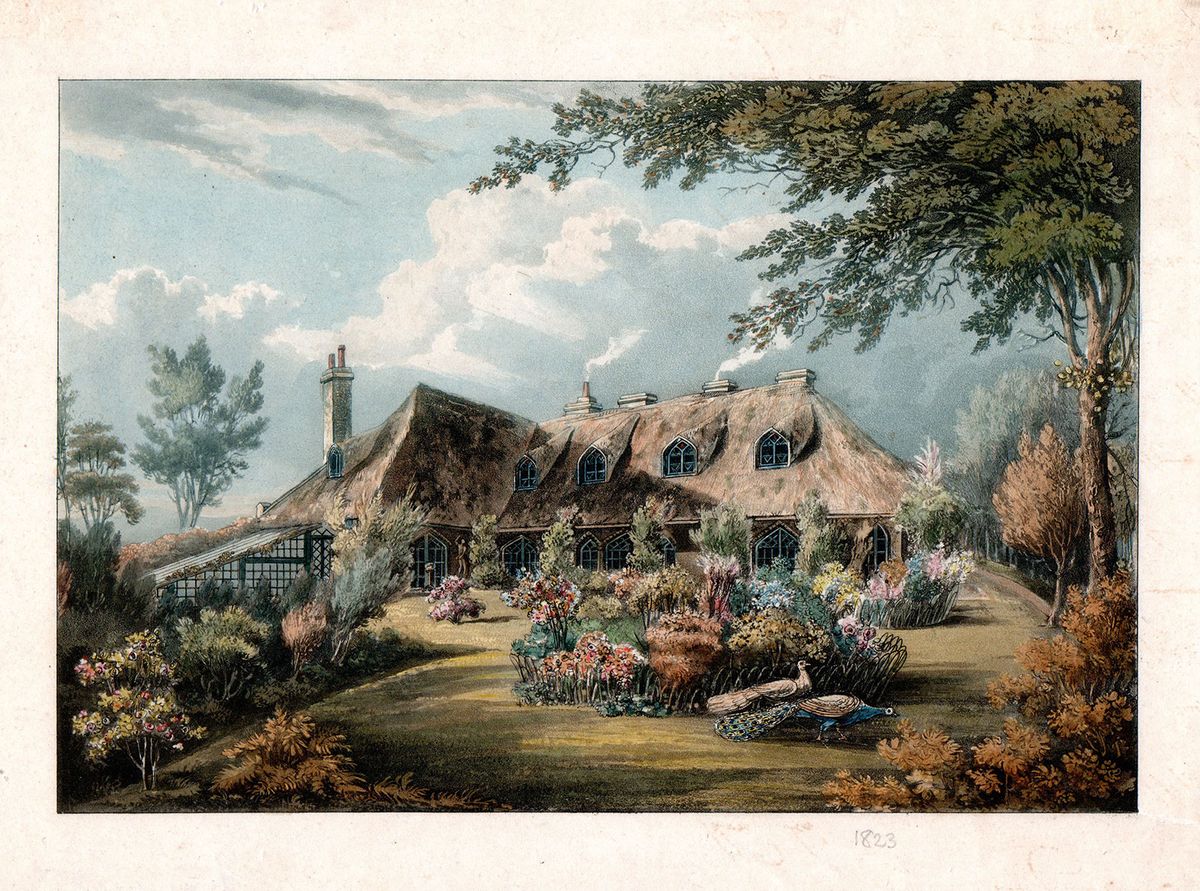The Cottage Orné is, despite its Frenchified name, an architectural form with a peculiarly British—even English—parenthood. Houses designed in this manner were supremely inventive demonstrations of the process of design enquiry, rooted in the relationship between architecture and landscape.
Roger White’s new wide-ranging survey is the first comprehensive scholarly treatment of this overlooked subject in a single book. It is a rich source book, exploring all the significant trends and examples, and will be especially valuable to those who wish to mine this rich topic for motives other than architectural history. We find all the great late-Georgian architects in this book: Robert Adam, John Soane and John Nash (neo-Classical credentials notwithstanding—Laugier’s “primitive hut” hovers in the background).
The surprisingly elastic Cottage Orné style, with its asymmetry, thatched roofs, Gothic or Tudor windows, and rustic porches, appears to have spread from England throughout the British Isles, and from there to Europe, Australia and North America. White rightly identifies the origins of the style in ornamental park and garden buildings, of which the earliest example may be Merlin’s Cave (designed by William Kent in 1735) in Queen Caroline’s garden at Richmond—“something like an old Haystack, thatch’d over”. Not long after, Thomas Wright was remodelling estate cottages for the Duke of Beaufort at Badminton with ornamental thatch and rustic timber porches, aesthetically closely linked to his designs for park and garden buildings, especially “hermitages” or “root houses”.
Then came the atmospheric retreats designed for the gentry and aristocracy. For example, the 1740s Egge Cottage, Edgehill, was a new stone-and-thatched house designed by its owner, Sanderson Miller, to look like an occupied portion of a castle ruin. As White observes, this building was a thoroughly artistic endeavor “for scholarly contemplation, picnics and other entertainments”.
Such projects were in delicious contrast to the prevailing mode of classically inspired architecture. Revealingly, the cottage-hermitage at Enville Hall in Worcestershire elicited the following response from a 1777 visitor: “This humble cot, its little circular sloping lawn in front, the graceful clustering of trees, that verge the area, and form a perfect canopy over the building have greater power to charm the eye of taste, than the most magnificent temple, loaded with all the finery art can give.”
The Cottage Orné style was imposed on a country tenantry by aesthetically minded landowners, or their persuasive architects and designers. Gate lodges, farmhouses, dairies, almshouses were all swept up in this ornamentalising style, which had a staggeringly long reign from the 1760s until the 1840s. One of finest examples is the “picturesque” village group of Blaise Hamlet, designed as homes for retired estate workers—the client was Quaker banker, John Scandrett Harford, in 1810.
The Cottage Orné was beloved of certain Scottish and Irish landowners, as is exemplified in the Swiss Cottage at Cahir. It also became popular with the British middle classes, building new country homes, close to towns, but unconnected to rural estate. J.B. Papworth in Rural Residences (1818) contended that the Cottage Orné was “a new species of building” that was not properly used for “the habitation of the laborious, but of the affluent”.
The chosen style for many places of popular middle-class resort, it can be seen that the thatched and rendered charms of Sidmouth, the Isle of Wight and the Lake District, provided happy scope. Pattern books played an essential role in the spread of ideas and imitable designs, often emphasising the way the style worked with landscape. James Malton, in Designs for Rural Retreats (1802), said his designs were such that the farmhouse “may agree and correspond with the surrounding scenery”.
This book is an excellent and enlightening survey, and also explores the rustic cottages of French, Russian, Danish and German aristocratic estates, and the Cottage Orné style (or “cottage style”) in the US, Australia and New Zealand during the mid-19th century. In his conclusion, White observes that the Cottage Orné style is not “a serious style for serious people”. But his writing demonstrates that this is not entirely the case, and there is a serious core to this book.
In understanding the Cottage Orné, we gain a clearer understanding of the story of English architecture and the story of the English house. This subject is now accessible to a new audience and revealed the surprising philosophical and aesthetic context of a style, which, in the consideration of this reviewer, has a valid claim to be the English style.
• Jeremy Musson is an author, lecturer, historic buildings consultant and trustee of the Country House Foundation. He is the author of Up and Down Stairs (2009), English Country House Interiors (2011), The Drawing Room (2014) and Robert Adam: Country House Design, Decoration and the Art of Elegance (2017)
Roger White, Cottage Ornés: the Charms of the Simple Life, Yale University Press, 272pp, £40, $50 (hb)


